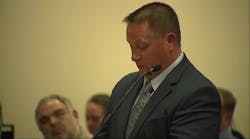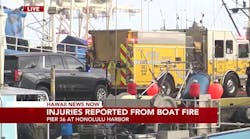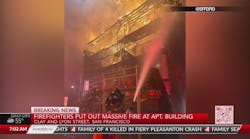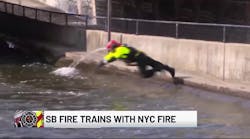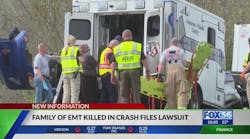Members of the Freehold Fire Department were summoned from their beds to handle a raging fire in the 80-year-old, wood-frame structure. It should be noted that in its early years, the building at 91 Throckmorton St. was home to a local bakery. In its earliest incarnation the building was actually a large, 2 1/2-story residential dwelling.
The building was composed of two distinct sections. The original wood-frame building was enlarged at some point during the 1960s. A separate masonry structure was built to provide a large meeting area/banquet hall, and tied into the frame structure.
In the years following World War II, the local African American community grew in prominence. Many of the members of the lodge were veterans and they felt that their organization needed a new home. That was the genesis of the lodge hall that came into being on Throckmorton Street.
A taxi driver who happened to be passing the hall discovered the blaze. The quick-thinking man immediately drove to the fire station that is located about two blocks from the lodge hall. A general alarm of fire was transmitted at 5:23 A.M. for a reported structure fire. Approximately 65 people deployed under the command of Fire Chief Larry Jackson responded on the initial alarm.
First-arriving fire units were met by a heavy body of fire rolling out into the street. The department was fortunate in that the power lines were located on the opposite side of the street and were never a threat to the operating force. Jackson was the first person to arrive. Quickly sizing up the task facing his troops, he immediately radioed for a full second-alarm assignment to respond and stage at his station. He wanted have the ability to deploy his forces and then assign mutual aid as the situation dictated.
Upon arrival, Jackson was met by a number of citizens who informed him that the caretaker and several other people might be in the facility. The caretaker, who lived part time in the facility, was known to have his grandchildren stay with him on occasion. Sometimes, he provided a place for the homeless to spend the night.
Immediate attempts were made to initiate an interior attack for rescue purposes. Lines were stretched and the side door to the facility was forced. Unfortunately, members on the attack teams were quickly driven back by the heavy volume of fire blowing out of the structure. Jackson then quickly opted for a defensive attack on the structure in order to keep the fire from spreading to nearby residential and commercial occupancies.
The initial 13/4-inch attack lines were then abandoned and replaced by an array of master stream and tower ladder streams. Two-and-one-half-inch handlines were also stretched to the A and D sides of the fire to aid in the attack. The large-caliber devices were located on the A/B and B/C corners of the fire.
The Freehold Fire Department Incident Safety Group (ISG) was activated early in the operation. Ex-Chief Nolan Higgins was given command of the ISG and located his operating station at Jackson's command post. The department's accountability system was activated and all personnel on scene were tracked by the ISG.
Collapse zones were created. The command staff and the safety group then continually monitored the movement of personnel in the immediate vicinity of the structure. On a number of occasions, members were reminded to stay at a safe distance from the structure.
Over the course of the next half hour, the large-caliber devices brought the fire under control. Once the fire was knocked down, the only personnel who entered the main part of the structure were on the investigating team. Overhaul operations were undertaken in the rear masonry structure that was relatively unaffected by the bulk of the fire.
At one point during the height of the operation, Jackson was faced with a sudden loss of water supply. Not knowing the cause, he immediately initiated a call to the Monmouth County Emergency Communication Center for a regional tanker task force to be dispatched. Fortunately, the water supply came back on line in about 10 minutes.
At about the same time, a serious structural collapse potential was recognized. This was noticed shortly after the roof of the building fell in. This allowed for a full view of the actual condition of the interior of the structure. Jackson's choice of an exterior, defensive attack likely prevented a number of serious injuries to his firefighting teams.
Given the extensive commitment of local and mutual aid forces, a special rapid intervention team (RIT) was summoned from the federal fire department at Fort Monmouth. This let local resources concentrate on pressing home the fire attack.
The apparatus fleet for the Freehold department consists of three engine companies, a truck company, and a rescue vehicle. The total department force consists of an all volunteer roster of 110 members. Mutual aid forces at this incident consisted of the East Freehold Fire Company, Freehold Township Independent Fire Company and Adelphia Fire Company, departments that have worked together as a part of the regional mutual aid network. As a part of the second-alarm procedures, the Englishtown Fire Department was dispatched by the county radio system to provide a cover assignment at the Freehold Fire Department's station during the period of active combat. The Freehold First Aid and Emergency Squad set up an incident rehabilitation sector and monitored the operation for any potential injury or fatigue-related problem.
The Monmouth County Field Communications mobile command post was dispatched as per protocol, owing to the extensive mutual aid commitment. Logistical support for the rehab and refreshment needs of the responding personnel was provided by the Adelphia Fire Company Ladies Auxiliary and the Freehold First Aid Squad Auxiliary.
Sadly, it should be noted that a disgruntled member of the lodge is alleged to have started the fire for personal reasons. The individual who lost his life was a long-time, active member of the lodge. The fire remains under investigation by the Freehold Police Department, the Monmouth County Fire Marshal's Office and the Monmouth County Prosecutor's Office. The suspect was quickly identified by information generated by the Freehold Police Department.
In reflecting on this operation, Jackson noted the following positive points:
- a. Mutual aid functioned as expected.
- b. The Incident Safety Group functioned as expected.
- c. There was only one minor injury to a Freehold firefighter.
- d. The accountability system proved its worth.
